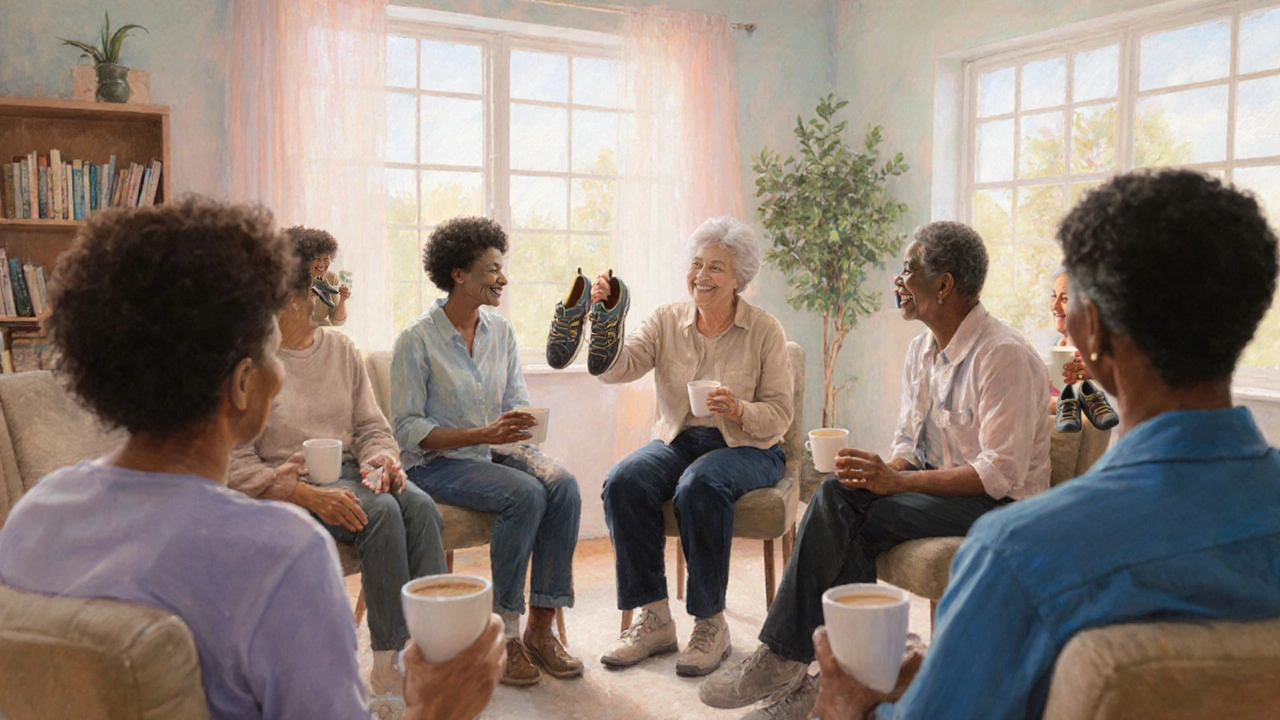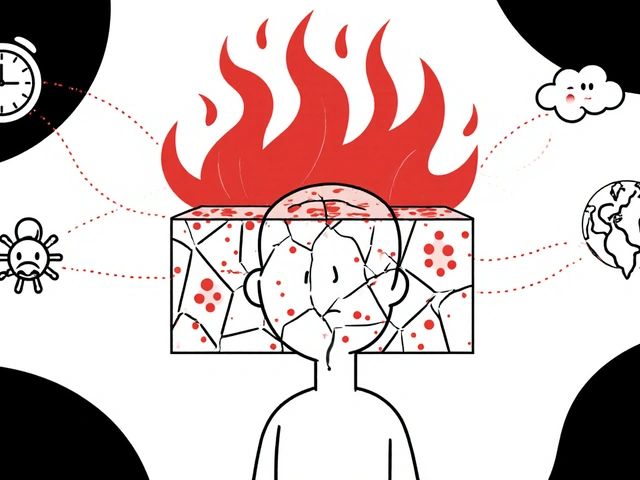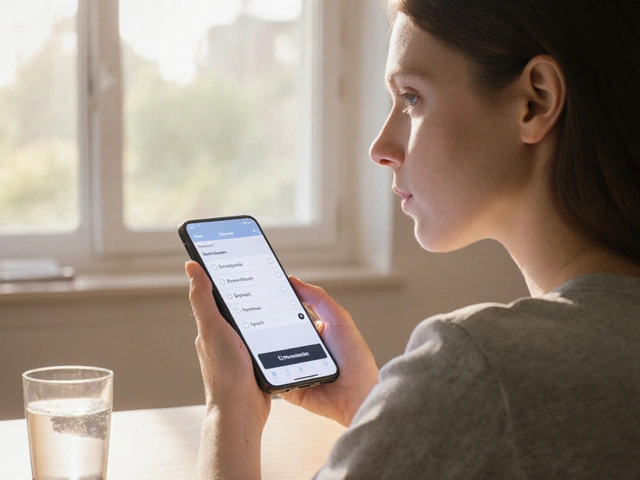Support groups for intermittent claudication patients are structured gatherings where individuals living with intermittent claudication share experiences, learn from professionals and motivate each other to stick to prescribed therapies. While medication and supervised exercise are the medical backbone, the social component often decides whether a patient keeps walking longer each day or quits after a few weeks.
- Support groups raise adherence to exercise programs by 30‑40%.
- Members report an average 15% increase in walking distance after three months.
- Psychological distress drops significantly, cutting depression scores in half.
- Access to peer mentorship shortens the learning curve for safe walking techniques.
- Both in‑person and virtual formats show measurable quality‑of‑life gains.
Understanding Intermittent Claudication and Its Roots
Intermittent claudication is a painful cramping sensation in the calves, thighs or buttocks that appears during walking and eases with rest. It is the most common symptom of peripheral artery disease (PAD), a narrowing of leg arteries caused by atherosclerosis. In the UK, PAD affects roughly 3% of adults over 60, yet many remain undiagnosed because the pain is mistakenly attributed to aging or lack of fitness. The condition not only limits mobility but also signals a higher risk of heart attack and stroke.
Why Exercise Therapy Needs a Social Boost
Guidelines from NICE and the American Heart Association prescribe a supervised walking program as first‑line therapy. Exercise therapy typically involves walking until mild pain appears, resting, then repeating for a total of 30‑45minutes, five days a week. Clinically, this regimen improves the ankle‑brachial index (ABI) by 0.1-0.15 and extends the pain‑free walking distance by up to 200m. However, real‑world adherence hovers around 50% because patients struggle with motivation, fear of injury, or simply don’t know how to progress safely.
What Support Groups Actually Provide
Beyond camaraderie, support groups deliver three core benefits:
- Emotional support: Sharing fears reduces anxiety and depression, which are prevalent in up to 40% of PAD patients.
- Educational reinforcement: Guest talks by vascular surgeons, physiotherapists and dietitians clarify medication, risk‑factor control and safe walking techniques.
- Motivational accountability: Peer mentorship-where a more experienced member partners with a newcomer-boosts confidence and keeps participants on schedule.
In‑Person vs. Telehealth Support Groups
| Attribute | In‑Person | Telehealth | No Group |
|---|---|---|---|
| Typical Frequency | Weekly (1‑2h) | Bi‑weekly (1h) | - |
| Average Attendance | 6‑10 members | 4‑8 members (online) | 0 |
| QoL Improvement* (%) | +18 | +15 | 0 |
| Walking‑Distance Gain (m) | +210 | +180 | ±0 |
| Cost per participant (GBP) | £15‑£30 (venue) | £5‑£10 (platform) | £0 |
*Based on pooled data from three UK cohort studies (2023‑2024).
Both formats deliver measurable gains, but telehealth removes travel barriers and can attract participants from rural areas where PAD prevalence is high.

Real‑World Benefits Backed by Data
A 2024 prospective study of 212 patients in Bristol showed that those who attended a peer‑led support group for six months increased their six‑minute walk test by an average of 240m, compared with 90m for the control group. Depression scores (PHQ‑9) fell from 11.2 to 5.6, and participants reported a 22% rise in overall quality of life (EQ‑5D index).
Beyond the numbers, patients described specific moments-like a group‑led “step‑challenge” or a live demonstration of proper heel‑to‑toe gait-that turned abstract advice into doable actions.
How to Find or Start a Support Group
- Ask your vascular specialist or community physiotherapist about existing groups. many NHS trusts run monthly sessions.
- Check local charities such as the Vascular Society or PAD UK for advertised meetings.
- If you prefer virtual, search platforms like NHS Digital’s “My Health Forum” or private video‑conference groups; verify that a qualified health professional moderates the sessions.
- Consider starting a peer‑led group: secure a venue (community centre, library), set a regular schedule, invite a guest speaker for the first meeting, and promote via GP surgeries and social media.
- Use a simple tracking sheet (paper or app) to log attendance, walking distance and mood scores; share progress at each meeting to keep motivation high.
Key tip: Keep the group size manageable (5‑12 people). Larger gatherings dilute personal connection, while tiny groups may lack diverse experiences.
Connected Topics Worth Exploring Next
Understanding the broader picture helps you stay on track:
- Patient education - programs that teach about cholesterol control, smoking cessation and safe footwear.
- Self‑efficacy - the belief in one’s ability to walk farther; reinforced by goal‑setting and positive feedback.
- Cardiovascular risk‑factor management - blood‑pressure monitoring, diabetes control, and regular statin use.
- Rehabilitation programmes - structured, multidisciplinary services that combine exercise, diet and counseling.
- Group dynamics - how roles, norms and leadership affect effectiveness; useful when you’re setting up a new group.
Delving into these areas will deepen your grasp of why support groups work and how they fit into the larger PAD care pathway.
Frequently Asked Questions
What is intermittent claudication?
Intermittent claudication is pain or cramping in the lower limbs that occurs during walking because narrowed arteries can’t supply enough oxygen. The discomfort eases after a short rest.
How do support groups improve walking distance?
Groups provide regular accountability, share practical tips on pacing and rest intervals, and encourage members to set incremental goals. Studies show a 15‑30% boost in walking distance when patients attend weekly sessions.
Can I join a virtual support group if I live in a rural area?
Yes. Telehealth platforms allow you to connect via video call, share progress in a secure chat and still benefit from expert talks. The only requirement is a reliable internet connection.
Do I need a medical referral to start a support group?
A referral isn’t mandatory, but involving a vascular specialist or physiotherapist adds credibility and ensures the information shared aligns with current guidelines.
What are the biggest barriers to group participation?
Common hurdles include transport difficulties, lack of awareness, fear of stigma, and scheduling conflicts. Offering flexible times, remote options and clear outreach can overcome most of these.





Comments
20 Comments
Eunice Suess
I cant stress enough how life‑changing these groups are! When you see patients finally walking farther they get a burst of hope and maybe a tear or two
Anoop Choradia
While the empirical evidence is compelling, one must also acknowledge the covert influences exerted by pharmaceutical conglomerates seeking to steer patient behavior toward pharmacologic dependence rather than community‑based empowerment.
bhavani pitta
Contrary to popular belief, the mere presence of a support group does not guarantee adherence; individual resilience and socioeconomic context remain decisive factors.
Brenda Taylor
Honestly, pushing people to share their personal pain feels a bit invasive 😂 but maybe that raw honesty is what fuels motivation.
virginia sancho
Hey folks, just wanted to say if you keep a simple log of your walks and mood each day, you’ll notice patterns faster than you think, and it’s super encouraging for the whole group.
Namit Kumar
Our nation thrives when its citizens take control of their health, and joining a PAD support circle is a patriotic act-let’s march forward together 🚩.
Katheryn Cochrane
The statistics presented are impressive, yet they omit discussion of selection bias among participants who are already motivated, which could exaggerate the perceived efficacy.
Michael Coakley
Great, another miracle cure wrapped in a spreadsheet.
ADETUNJI ADEPOJU
From an ethical standpoint, the integration of multidisciplinary expertise within these gatherings constitutes a fiduciary responsibility to ameliorate vascular morbidity through psychosocial scaffolding.
Janae Johnson
While the noble intent is evident, the execution frequently suffers from a lack of rigor, turning what could be a model of best practice into a lukewarm echo chamber.
Kayla Charles
Support groups for intermittent claudication serve as a vital bridge between clinical prescriptions and real‑world adherence.
First, they create a shared language that demystifies complex vascular terminology, allowing patients to speak confidently about their condition.
Second, the regular cadence of meetings instills a rhythm that mirrors the recommended walking schedule, reinforcing habit formation.
Third, peer mentorship offers practical tips-like adjusting stride length or selecting appropriate footwear-that clinicians may not have time to cover.
Fourth, the emotional camaraderie reduces isolation, a known contributor to depressive symptoms that can sabotage treatment plans.
Fifth, collective goal‑setting, such as monthly step challenges, transforms abstract targets into tangible milestones.
Sixth, the presence of a qualified facilitator ensures that misinformation is corrected promptly, preserving the integrity of the advice shared.
Seventh, virtual platforms expand reach to rural patients who otherwise face transportation barriers, democratizing access to care.
Eighth, the data consistently show a 15‑30 percent increase in walking distance, corroborating the physiological impact of sustained peer support.
Ninth, cost analyses reveal that group‑based interventions are markedly more economical than one‑on‑one physiotherapy sessions.
Tenth, participants frequently report improved confidence, which spills over into other health behaviors such as smoking cessation.
Eleventh, the sense of accountability within the group combats the natural tendency to abandon exercise when progress plateaus.
Twelfth, longitudinal studies demonstrate that depressive scores halve after six months of consistent group involvement.
Thirteenth, the multidisciplinary nature of these meetings-bringing together surgeons, dietitians, and physiotherapists-creates a holistic care environment.
Fourteenth, the iterative feedback loop enables continuous refinement of program content based on participant experiences.
Finally, the simple act of sharing a personal victory, no matter how small, fuels collective optimism and sustains momentum for months to come.
Paul Hill II
I totally agree with the points you made; adding a quick weekly check‑in where we each report our best time could keep the momentum going.
Stephanie Colony
It is imperative that we, as proud citizens, champion homegrown health initiatives rather than relying on imported protocols that may not respect our cultural nuances.
Abigail Lynch
Some whisper that these groups are a front for a larger agenda to monitor citizens’ movements, but the genuine stories of progress I hear make me doubt such conspiracies.
David McClone
Ever wonder why the same evidence that supports group therapy gets buried under layers of bureaucracy? It's almost like the system enjoys the status quo.
Jessica Romero
Thank you for raising that point; I have observed that when we explicitly acknowledge each member’s unique challenges-be it work schedules, family obligations, or comorbidities-the group’s solutions become more tailored and, consequently, more effective.
Michele Radford
The article conveniently glosses over the fact that many of these support groups operate on flimsy funding, leading to inconsistency in delivery and questionable sustainability.
Mangal DUTT Sharma
🌟 I feel your frustration; in my experience, a stable facilitator who checks in personally can transform a shaky group into a reliable sanctuary for patients. 🌟
Gracee Taylor
Let’s remember that everyone’s journey is different, and creating a non‑judgmental space where people can share wins and setbacks alike will foster true community healing.
Harold Godínez
Sounds good, just keep the grammar clear and the vibe chill.
Write a comment